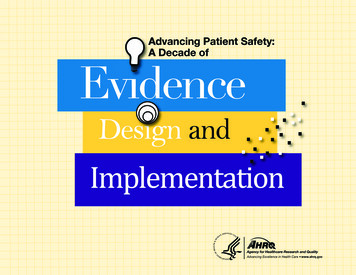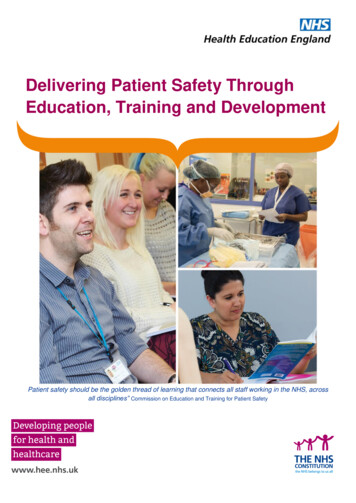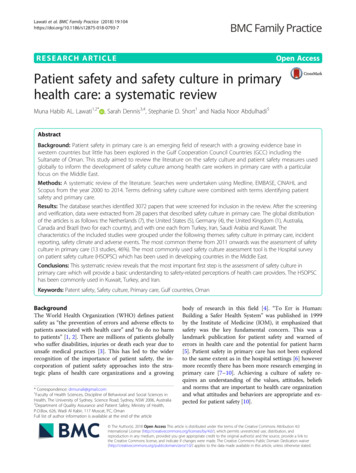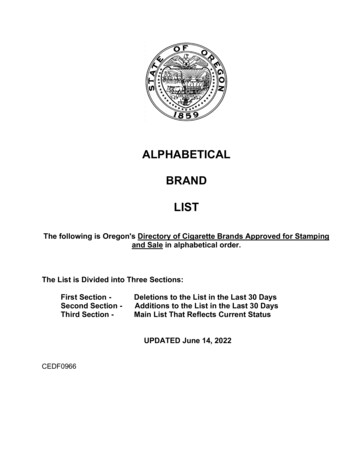
Transcription
Advancing Patient Safety:A Decade ofEvidenceDesign andImplementationAgency for Healthcare Research and QualityAdvancing Excellence in Health Care www.ahrq.gov
Advancing Patient Safety:A Decade of Evidence,Design, andImplementationIntroduction1999Patient safety was a fairly newfield when the Institute of Medicine’s(IOM) sentinel report, To Err isHuman: Building a Safer HealthSystem, captured the Nation’sattention in late 1999. While the IOMmade recommendations to Congressfor investigating medical errors andimproving patient safety, the realitywas that extensive foundationbuilding needed to occur beforemeaningful improvements could beput into action. At the direction ofCongress, the Agency for HealthcareResearch and Quality (AHRQ), inconjunction with its Federal partnersand non-Federal stakeholders, startedthe process of building the foundationto better understand patient safetychallenges and how effectivesolutions could be rapidlyimplemented.The IOM noted that many of theerrors in health care result from aculture and system that is fragmented,and that improving health care needsto be a team sport. Research indicatedthat mistakes were not due toclinicians not trying hard enough;they resulted from inherentshortcomings in the health caresystem. Today, while progress hasbeen made, it has not spread evenlythroughout the Nation’s health caresystem.Following are some highlights ofthe Agency’s contributions inadvancing patient safety during thepast decade. These highlights areorganized by year and by three key,ongoing challenges: Develop a solid evidence base. Design and evaluate usefulstrategies and tools. Disseminate information andtools for implementation.Develop a SolidEvidence BaseTo build a robust patientsafety infrastructure, the Agencybegan its work to gain a betterunderstanding of the systemic factorsthat combine in unanticipated waysand threaten patient safety.Researchers studied the best ways toidentify and report on these factorsand examined the impact that workingconditions, health care informationtechnology, and enhanced providerexpertise could have on addressingpatient safety challenges.1999The Agency’s official designationas the Federal lead in patient safetybegan when the Healthcare Researchand Quality Act of 1999 was signedinto law. It required AHRQ to“conduct and support research andbuild private-public partnerships to:(1) identify the causes of preventablehealth care errors and patient injury inhealth care delivery; (2) develop,demonstrate, and evaluate strategiesfor reducing errors and improvingpatient safety; and (3)disseminate such effectivestrategies throughout thehealth care industry.”Because of work alreadyunderway at that time,AHRQ was poised torelease a call forresearch focused onsystems-related best practiceswithin weeks of the release of the ToErr is Human report.1
20002001220002001Setting a DirectionSynthesizing Existing Evidenceand Identifying KnowledgeGapsIn early 2000, just 60 days afterthe IOM report was published, theFederal Government, through anAHRQ-led task force, released DoingWhat Counts for Patient Safety:Federal Actions to Reduce MedicalErrors and Their Impact. This report,which reflected energy andcommitment to improving care,detailed more than 100 actionsFederal entities could take to addressthreats to patient safety. By 2003, thevast majority of these actions wereunderway or completed.Later in 2000, under AHRQleadership, that task force held aNational Summit on Medical Errorsand Patient Safety. The meetingfocused on multistakeholdercollaboration and input to be used byAHRQ in setting its patient safetyresearch agenda. By the end of 2000,Congress directed 50 million toAHRQ to fund patientsafety research andimprovement activities.With extensive input fromCongress, the National Summit, and abroad group of stakeholders, twomajor efforts were undertakenfollowing Congressional directivesand using deliberations from the 2000National Summit. First, AHRQformulated a research agenda focusedon identifying available evidencebased patient safety practices, gaininginformation on the requirements andeffective use of medical errorreporting systems, understanding theimpact of working conditions andtechnology, and finding optimalmethods for training professionals.Second, AHRQ enlisted researchers atthe University of California, SanFrancisco (UCSF)—StanfordUniversity Evidence-based PracticeCenter to review the publishedliterature on the efficacy of variouspatient safety practices. This work,published as AHRQ Evidence ReportNo. 43: Making Health Care Safer(http://www.ahrq.gov/clinic/ptsafety/),was the first effort toapply evidencebased analysis toexisting patientsafety practices.Once published, thereport wasimmediately used byproviders as well asthe National QualityForum (NQF), apublic-private partnership establishedas a voluntary consensus standardssetting organization, as it set aboutpublishing and updating a set ofendorsed patient safety practices.
20022003Awarding the Initial PatientSafety Grants2002With the research agenda andevidence report serving as points ofdeparture, extensive work began tocompile needed evidence. Nearly 100grants were awarded to lay thegroundwork for reducing harm topatients. The focus of these grants wasto: Explore different ways ofreporting, analyzing, and usingdata on medical errors. Investigate clinical informaticsalong with costs, feasibility, andusability factors. Examine the working conditions ofproviders, including the effects ofstaffing, work schedules, fatigue,and sleep deprivation onperformance. Provide funding to centers ofexcellence to support and sustaindemonstrated and programmaticapproaches to patient safetyresearch. Provide funding to developmentalcenters to encourage newresearchers with innovative ideasto focus on patient safetychallenges. Educate and train health careprofessionals about the emergingpatient safety concepts, findings,and ways to disseminate the newinformation.Honoring Former AHRQDirector and Patient SafetyVisionaryWith work on AHRQ-fundedgrants underway around the country,the Agency lost one of the Nation’sforemost patientsafety visionarieswhen thenDirector John M.Eisenberg, M.D.,passed away inMarch 2002.Later that year,the NQF and theJoint Commission established the JohnM. Eisenberg Patient Safety andQuality Awards in Dr. Eisenberg’smemory. These annual awardsrecognize the achievements ofindividuals who have made significantand lasting contributions to improvingpatient safety and health care quality.They also recognize individuals andorganizations that, througha specific initiative orproject, have made animportant contribution topatient safety and healthcare quality in the areasof research or systeminnovation.Design and EvaluateUseful Strategies andToolsAHRQ’s initial grants helped builda patient safety knowledge base andinformed the Agency’s thinking aboutthe next steps it needed to take. As theknowledge base continued to evolve,it became clear that AHRQ needed toproduce sound research studies and toensure that the information,educational content, new approaches,and tools it provided were relevant toproviders as they initiated their ownpatient safety improvement efforts.What follows is a brief description ofsome of the projects that werecarefully designed, developed, andevaluated.2003Launching AHRQ WebM&MTo take advantage of the lessonsthat have been available fromhospital-based morbidity andmortality conferences and make themmore widely available andaccessible to the field,the Agency implementedAHRQ WebM&M,Morbidity & MortalityRounds on the Web(www.webmm.ahrq.gov),through a contract with3
20034UCSF. AHRQ WebM&M serves as afree, online journal and forum for theexamination of a variety of patientsafety and quality issues. It featuresanalysis of medical error cases byrecognized experts and providesinteractive learning modules forhealth care professionals, clinicians,administrators, patient safety officers,and trainees. Since its launch, AHRQWebM&M has grown in popularityand continues to be one of AHRQ’smost frequently visited Web sites.Using Patient Safety IndicatorsTo help organizations understandand quantify patient safety events andareas of vulnerability in theirinstitutions, AHRQ developed auseful measuring and monitoringtool: the Patient Safety Indicators(PSIs). The tool includes 20 hospitallevel and 7 regional measures. Byusing hospital administrative data,PSIs can identify pressure ulcers,postoperative pulmonary emboli,accidental punctures and lacerations,and many other departures from safecare that are preventable. AHRQcontinues to make the PSIs availableas a free software program(www.qualityindicators.ahrq.gov) anduses PSIs regularly in its annualNational Healthcare Quality Reportand National Healthcare DisparitiesReport.Training the Patient SafetyImprovement CorpsIn response to the need to expandthe patient safety knowledge andskills of midlevel professionalsresponsible for investigating medicalerrors and initiating improvements,AHRQ partnered with theDepartment of Veterans Affairs’National Center for Patient Safetyand began the first of four 9-monthPatient Safety Improvement Corps(PSIC) training programs.Participants received training on toolsand topics including analyzing rootcauses, analyzing health care failuremodes and effects, applying humanfactors principles, assessing patientsafety culture, and making a businesscase for patient safety. By theprogram’s end, teams had beentrained in every State, as well as theDistrict of Columbia and Puerto Rico.Feedback the Agency received thatPSIC graduates were, in turn, trainingtheir own personnel in patient safetyprinciples acquired from the programprovided evidence that this programrepresented a significant step indisseminating patient safetyknowledge throughout the country.
2004Fostering a Culture of Safety2004IOM’s To Err is Human notedthat health care providers wereremiss in developing a culture ofsafety in their daily operations.Aviation and other high-riskindustries were well aware thatorganizational leadership shapesculture, which in turn drivesbehavioral change, the pace ofimprovement, and ultimatelyoutcomes. Health care had yet tolearn this lesson. To assistorganizationsand theirunits inimprovingpatient safetyculture, AHRQdeveloped andreleased theHospital Surveyon Patient re/hospsurvindex.htm), apsychometrically tested and wellreceived survey instrument. This toolcontinues to help hospital andorganizational unit leaders assesstheir patient safety culture andidentify areas in need ofimprovement. Today, more than 600civilian and military hospitals andhealth care systems share data fromtheir surveys and are able to comparetheir results to national benchmarks.Results indicate that teamworkwithin hospital units and supervisorand manager support for patientsafety are areas of strength for mosthospitals, but nonpunitive responsesto errors and handoffs continue to beareas for improvement.Initiating a Health InformationTechnology PortfolioAs health information technology(health IT) increasingly wasrecognized as a promising way toimprove health care quality, safety,and efficiency, the Agencyallocated a substantial portion ofits patient safety budget to healthIT. The health IT portfolio led to 200projects that are currently distributedacross 48 States and included the fullspectrum of planning,implementation, demonstration, andevaluation phases that are essential tolaunch health IT projects effectively.To provide technical assistance andshare knowledge and findings, theAgency established a NationalResource Center for Health IT(healthit.ahrq.gov). All of the lessonslearned from these projects arehelping health care providers movecloser to a fully operational health ITsystem in support of improvedquality, safety, and continuity of care.Examining Safety Impacts ofthe Work EnvironmentAnother group of projectsyielding valuable results focused onproviders’ work environment. Assuspected, the 100 -hourworkweek—a traditional rite ofpassage for young physicians—wasfound to increase medical errors.AHRQ-funded studies found thatThe banking industry is more advanced in information technology than health care. I can takemoney out of my bank account anywhere in the world, but my hometown doctor can’t tell meresults from the lab across the street. – Carolyn M. Clancy, M.D., AHRQ Director5
2005medical interns continued to workshifts that exceeded the 80-hourworkweek limit set by theAccreditation Council for GraduateMedical Education in 2003 and thatthe long shifts medical internsworked led to 61 percent moreneedlestick injuries. Studies alsofound that after working extendedshifts, medical interns doubled theirrisk of car crashes when drivinghome from the hospital. A toolkit,“Implementing Reduced Work Hoursto Improve Patient Safety”(http://workhoursandsafety.org), wasdeveloped to help address some ofthe patient safety issues related toextended work hours.Disseminate Informationand Tools forImplementationAs the decadeprogressed and theknowledge basecontinued to expand,reports of successfulapplication of evidencebased strategies began toincrease. For example, byconsistently followingevidence-based procedures,some health care systems wereachieving significant reductions inhealth care-associated infections.6Unfortunately, these examples werethe exceptions. Many facilities stillwere not addressing patient safetyconcerns. AHRQ recognized thatgetting evidence to the field in waysthat provided organizations withadoptable solutions was crucial. Inpromoting widespread access toimportant resources, the Agencyredoubled its efforts in what hasbecome a long-term commitment.2005Disseminating Advances inPatient SafetyAHRQ released Advances inPatient Safety: From Research toImplementation (http://www.ahrq.gov/qual/advances/) as a way to share theprogress occurring in the first half ofthe decade. The four-volumepublication, comprising 140articles, sought to bridge thegap between the researchunderway and its integrationinto practice. Thecompendium covered a widerange of research paradigms,clinical settings, patientpopulations, reportingsystems, measurement andtaxonomy issues, tools andtechnology, implementationchallenges, safety culture, andorganizational considerations. Thevolumes helped fuel efforts toimprove patient safety and provideda measure of progress. Moreimportantly, they also provided asense of remaining challenges.Three years later, in 2008, thefour-volume Advances in PatientSafety: New Directions andAlternative Approaches(http://www.ahrq.gov/qual/advances2/)was released. It focused further onreporting systems, risk assessment,safety culture, clinical processimprovement, systems redesign,patient involvement, teamwork andcommunication, simulation, humanfactors applications, tooldevelopment, technology, andmedication safety.
Initiating the AHRQ PatientSafety Network2006As patient safety research andinformation began to grow, it becameclear that a consolidated resource forpatient safety information wasneeded. In response, the Agencydesigned requirements for the AHRQPatient Safety Network(www.psnet.ahrq.gov), a one-stop,online resource for patient safetyinformation. A team at UCSFimplemented and continues tosupport the project with weeklyupdates. Health care providers,researchers, administrators, andconsumers can access this resourceto learn about the latest news,research findings and publications,pertinent legislation, conferences,and tools related to patient safety.2006Building Health CareTeamwork NationwideHealth System jointly released acomprehensive training resource,known as TeamSTEPPSTM (TeamStrategies and Tools to EnhancePerformance and Patient Safety;teamstepps.ahrq.gov). Adapted fromprocedures that were originallydeveloped, tested, and refined forflight crews, the team-trainingcurriculum provides health careorganizations with evidence-basedtraining techniques for effectivecommunication and team building.More than 14,000 copies of thecustomizablecurriculum havebeen distributed toU.S. hospitals,health professionsschools, andmilitary medicalfacilities. Nearly1,000 master trainers havebeen trained and are prepared to trainother health care professionals.Reducing Central LineAssociated Blood StreamInfectionsBy using a comprehensive safetyprogram featuring a checklist toensure that health care workersfollow five crucial steps whenplacing a central-line catheter,AHRQ-funded researchers at JohnsHopkins University in Baltimorewere able to dramatically reduceblood stream infections. Withadditional funding from the MichiganHealth and Hospital Association’sKeystone Center intensive care unitproject, infection rates dropped 66percent over an 18-month period inthe 77 participating Michiganhospitals. As a result, 200 millionand an estimated 2,000 lives weresaved. Results of the sentinelKeystone Project study werepublished in the New EnglandJournal of Medicine.Despite the recognizedimportance of teamwork in aviationand other high-risk industries, it isonly recently that teamwork,coordination, and communicationhave started to be recognized as keyingredients in the delivery of safehealth care. AHRQ and theDepartment of Defense’s Military7
20078Using Simulation to PreventHarm2007Patients can sometimes beharmed unintentionally as clinicianslearn new procedures. Much of thetime the harm is not serious;however, some procedures, such ascomplex surgical operations, havevery thin margins of safety.Simulation provides a way for newlytrained clinicians to become skilledand more adept before treatingpatients.Concurrent with the recentgrowth of simulation centers inmedical schools, AHRQ initiated itsImproving Patient Safety throughSimulation Research grants program.These 19 simulation grants provide asafe environment in which providerscan acquire proficiency in variousclinical procedures: treating acutemyocardial infarction, insertingultrasound-guided central venouscatheters, diagnosing melanoma,providing obstetric emergencyresponse in rural hospitals, disclosingmedical errors, and demonstratinghow simulation can be used to designand develop an electronic patienttracking system in the hospitalemergency department.Designing the PhysicalEnvironmentAn emerging body of evidencefocuses on the physical environmentand how its design can serve tofacilitate or impede the quality andsafety of care that patients receive aswell as the work-life quality ofproviders. Designers of new hospitalconstruction during the past decadehave started to take advantage of thisresearch. AHRQ released a DVD,Transforming Hospitals: Designingfor Safety and Quality, that illustrateshow three hospitals incorporatedevidence-based design principles intheir construction and renovationprojects. These design principlesinclude single patient rooms andbetter ventilation systems forpathogen control; standardized roomlayouts; better lines of sight andreduced steps to the point of care;adjustable lighting; noisereduction materials; convenientplacement of hand-hygienedispensers; and safer systems forlifting and transporting patients.Engaging PatientsAHRQ teamed with the AdCouncil to launch a series of publicservice advertisements to helppatients understand the importanceof being active members of theirhealth care team, which in turnimproves thequality of care andprevents harmfulpatient safetyevents. The adsurged patients to asktheir cliniciansrelevant questions,take notes, follow upon test results, and bemindful of dischargeinstructions and recommendedfollowup care. The “Questions Arethe Answer” ad campaign featuredtelevision commercials, radiobroadcasts, print ads, and a Web site(www.ahrq.gov/questionsaretheanswer) with an interactive questionbuilder that enabled consumers todevelop and print a customized listof questions to take with them tomedical appointments.
2008Preventing Health CareAssociated Infections2008Data indicate that health careassociated infections (HAIs) are themost common serious complicationof hospital care, striking nearly 2million U.S. hospital patients,resulting in an estimated 99,000deaths, and costing the health caresystem up to 20 billion each year,according to the Centers for DiseaseControl and Prevention (CDC). Themost common HAI is methicillinresistant Staphylococcus aureus(MRSA). With some MRSA-relatedprojects already underway, Congressdirected AHRQ to work with itsFederal partners at the CDC and theCenters for Medicare & MedicaidServices to develop an action plan toidentify and help reduce the spreadof MRSA and related HAIs. Theaction plan is designed to: Reduce MRSA infections throughthe use of novel interventions. Determine scope, risk factors, andcontrol measures for hospitalacquired, community-onsetMRSA infections. Test methods to reducehospitalization for treatment ofcommunity-acquired MRSA. Understand the role ofinterfacility MRSA transmissionon overall infection rates. Understand the role of nursinghome transmission of MRSA anddevelop interventions to reducetransmission.Building on the success of theKeystone Project, the Agency alsosupported a nationwide expansion toreduce the rate of hospital-relatedcentral line-associated blood streaminfections (CLABSIs). Severalprivate organizations contributedfunds to broaden the scale of theprojects to all 50 States, to settingsbeyond intensive care units, and toother infections. In 2009, U.S.Department of Health and HumanServices Secretary Kathleen Sebeliuscalled on all hospitals to reduceCLABSIs by 75 percent over 3 yearsby using the research findings andfocused tools that AHRQ hassupported.Reducing HospitalReadmissionsAHRQ continued to promote andprovide funding to expand use of atool to help hospitals redesign thedischarge process and curtail costlyand unnecessary readmissions byensuring that patients have thenecessary information to recover athome. Called the “Re-EngineeredHospital Discharge Program,” orProject RED, it draws on input froma multidisciplinary health care teamand features a personalizedinstruction booklet and instructionsfor nurses to help patients understandafter-hospital care instructions,including how to take medicationsand when to make followupappointments. Additional funding led9
to the creation of a virtual nursedischarge advocate and a version ofthe tool adapted for patients with lowhealth literacy.Using Tools to Enhance PatientSafety200910To give providers a head start intheir efforts to give patients thesafest and highest quality of carepossible, AHRQ funded severalprojects (http://www.ahrq.gov/qual/pips/) to design, develop, andtest implementation-ready tools.AHRQ products that came about as aresult of these projects include YourGuide to Preventing and TreatingBlood Clots (www.ahrq.gov/consumer/bloodclots.htm) forconsumers and Preventing HospitalAcquired Venous Thromboembolism:A Guide for Effective QualityImprovement(www.ahrq.gov/qual/vtguide) forclinicians. The latter is acomprehensive tool to helphospitals and cliniciansimplement processes toprevent dangerous bloodclots. The 60-page guidedetails how to start,implement, evaluate, andsustain a quality improvementstrategy.Distributing an Evidence-BasedHandbook for NursesGiven the central role that nursesserve in patient care and thelikelihood that they are among thefirst health care professionals torecognize errors and prevent harm topatients, the Agency teamed with theRobert Wood Johnson Foundation todevelop and distribute a handbookfor nurses entitled Patient Safety andQuality: An Evidence-BasedHandbook for Nurses. Even thoughworking conditions may be less thanoptimal and the needs of patients arequite diverse, the opportunities forpatient safety and qualityimprovement are clearly addressed.More than 22,000 copies of thethree-volume handbook have beendistributed to nursing schools andclinicians in the field.2009Learning and ImprovingThrough Patient Safety EventReportingSince enactment of the PatientSafety and Quality Improvement Actof 2005 for establishing PatientSafety Organizations (PSOs), AHRQworked closely with its Federalpartners to refine and implementprovisions of the Act. Finalregulations governing PSOs werepublished in 2009. Through the Act,PSOs can collect voluntarily reportedpatient safety events and share thesedata without fear of legal discoverybecause the law extends a legallysecure environment of privilege andconfidentiality protections forhospitals, clinicians, and othersworking under the auspices of PSOs.To ensure that patient safetyevents reported to PSOs can becollected in a standardized fashionand analyzed in a meaningful way,AHRQ coordinated the developmentof common definitions and reportingformats called the Common Formats(www.pso.ahrq.gov/formats/commonfmt.htm). They enable health careproviders to collect and submitinformation on patient safety eventsand unsafe conditions in anapples-to-applesfashion.Subsequent datasubmission to aNetwork ofPatient SafetyDatabases willenable AHRQ toreport on patientsafety in its annual NationalHealthcare Quality Report.Given that consumers can be animportant source of information for
understanding patient safety eventsand health care system failures,AHRQ, in another patient safetyevent reporting project, is developingspecifications for the futuredevelopment of consumer reportingsystems.Educating Patients AboutMedication Safety2010andbeyondBlood thinning medications suchas warfarin are used to treat harmfulblood clots that cause strokes, heartattacks, and other serious conditions.However, research shows that bloodthinners can have serious sideeffects. According to data fromAHRQ’s Nationwide EmergencyDepartment Sample, more than 7,300Americans a year are treated in U.S.emergency departments foruncontrolled bleeding associatedwith use of blood thinners, and abouthalf have to be hospitalized. To helppatients use these medications safely,AHRQ released two bilingual tools,a patient booklet entitled BloodThinner Pills: Your Guide to UsingThem Safely(www.ahrq.gov/consumer/btpills.htm),and a 10-minute educational videoentitled Staying Active and Healthywith Blood videos).Looking Toward 2010 andBeyondThe progress cited in thisdocument bears witness to theinnovation, energy, and skillfulexecution of many individuals andorganizations that are at the leadingedge of conducting patient safetyresearch and translating thatknowledge into useful tools andstrategies for implementation. To besure, much has been done to improvethe safe delivery of health care sincethe IOM report was released 10 yearsago. For the decade ahead, AHRQ iseager to support the advances andimproved understanding that willcontinue to occur in health IT,reporting systems, infection control,medication safety, physicalenvironment design, systems andclinical process redesign, simulationand training, evidence-based toolsand resources, patient-centered care,and patient safety culture change,among other developments.Yet, no one is completelysatisfied with the extent of progress.The Agency is ever mindful of thechallenges and improvementopportunities that remain. Whilethere is a measure of success inidentifying and verifying practicesthat improve safety, further work isneeded in demonstrating howpractices get implemented andintegrated into clinical workflow andin ensuring there is a full andunrelenting commitment toproviding the safest care possible.This commitment needs to existthroughout the continuum of care.Even when the evidence issubstantial and the integration intopractice is well conceived, buy-infrom providers and decisionmakersoften remains an issue. For patientsafety practices and gains to bewidely distributed and sustained,institutional leadership will need tobe informed, actively engaged, andsupportive.The experience gained in the firstdecade confirms the complexity ofour changing health care system. Inthe years ahead, new challenges willarise for providers and institutionalleaders as they strive to deliver safe,high-quality care. We have learnedthat safety is a changing, emergentproperty of systems, and as ourhealth care system changes so willthe threats to patient safety. Thepromising beginnings and lessonslearned in the first decade will serveus well as we undertake thechallenges that lie ahead.11
Advancing Patient Safety: A Decade ofEvidence, Design, and ImplementationPatient safety was a fairly new fieldwhen the Institute of Medicine’s sentinelreport, To Err is Human: Building aSafer Health System, captured theNation’s attention in late 1999. Whilethe Institute of Medicine maderecommendations to Congress forinvestigating medical errors andimproving patient safety, the reality wasthat extensive foundation buildingneeded to occur before meaningfulimprovements could be put into action.At the direction of Congress, AHRQ, inconjunction with its Federal partners andnon-Federal stakeholders, started theprocess of building the foundation tobetter understand patient safetychallenges and how effective solutionscould be implemented. This timelinepresents highlights of the Agency’scontributions in advancing a safer U.S.health care system during the pastdecade.National Summiton Medical Errorsand PatientSafetyHealthcareResearch andQuality Act of1999Institute ofMedicine’s ToErr is Human:Building a SaferHealth SystemDoing WhatCounts forPatient Safety:FederalActions toReduceMedical Errorsand TheirImpactAHRQ patientsafety researchagendaPatient safetygrantsEvidence ReportNo. 43: MakingHealth Care SaferJohn M. EisenbergPatient Safetyand QualityAwards1999 2000 2001 2002
Advances inPatient Safety:New Directionsand AlternativeApproachesHealth careassociatedinfections actionplanHealth informationtechnologyportfolioPatient SafetyIndicatorsNational ResourceCenter for Health ITPatient SafetyImprovementCorps“ImplementingReduced WorkHours to ImprovePatient Safety”AHRQ WebM&M,Morbidity &Mortality Roundson the WebHospital Surveyon Patient SafetyCulture“Pro
(IOM) sentinel report, To Err is Human: Building a Safer Health System, captured the Nations attention in late 1999. While the IOM made recommendations to Congress for investigating medical errors and improving patient safety, the reality was that extensive foundation building needed to occur before meaningful improvements could be put into action.










